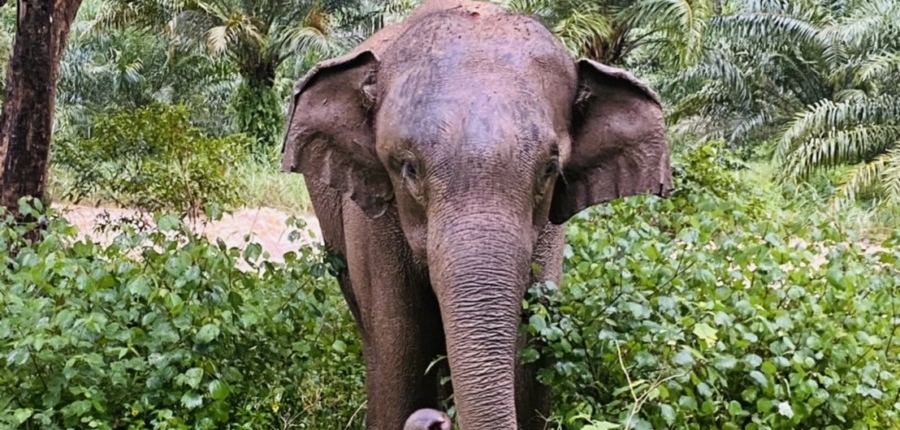The Asian Elephant
Learn more about these gentle giants, Elephas maximus, with some helpful facts.
Asian elephants vs African elephants
African elephants and Asian elephants are the only remaining species of the elephant family, but elephants once lived on every continent across the world, apart from Australia and Antarctica, inhabiting a range of environments from rainforests, to savanna to deserts.
Asian elephants have three main subspecies- Sumatran (the smallest and palest), Indian (in the middle) and Sri Lankan (usually the biggest and darkest). The world’s largest elephant on record was actually an Indian elephant – he weighed 7.7 tons and stood 3.43m tall! Elephants typically weigh up to 6.5 tons in Africa and 5.5 tons in Asia.
Elephants are unable to trot or run because they cannot have all four feet off the ground at the same time. But they can walk very fast: Asian elephants can move at 25 km/hour and African elephants can reach 40km/hour.
In African elephants, the males and females grow tusks, but in Asian elephants, it is normally only the males that have tusks. However a female Asian elephant can have “tushes”, which are basically very small tusks. The tusk is essentially an elephant’s incisor, albeit very elongated, and if an elephant loses his tusks, they do not grow back.
Some male Asian elephants never grow tusks – in Thailand these elephants are affectionately known as “ladyboys”.
African elephants have a strict hierarchy by age and are led by the oldest and wisest female, the matriarch. Wild Asian elephants have more changeable social networks.
There are about 400,000 African elephants left in the world, but only 40,000 or so Asian elephants. This is why Asian elephants have been classified as an endangered species by the World Wildlife Fund (WWF) and the International Union for the Conservation of Nature (IUCN), and why conservation and protection is so important to support their populations.
What do elephants eat?
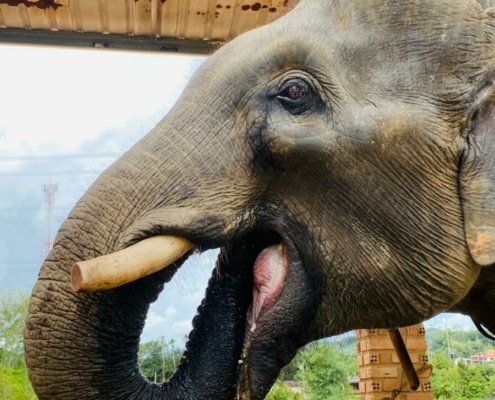
Elephants have the largest teeth of any mammal, and they get through six sets of molar teeth during their lifetime. They have four molar teeth which get replaced as they wear out. One tooth can weigh up to 5 kg and can be up to 40 cm long. The surface of African elephant molars has a lozenge shape repeat pattern, whereas Asian elephant teeth have surface ridges. They chew their tough food by moving the jaw from side to side, like cows and sheep.
Baby elephants are born after a gestation period of 22 months, the longest of any mammal, and weigh around 250 pounds/113kg. As large animals require a lot of nutrients to grow, young elephants drink up to three gallons of their mother’s milk per day and can continue nursing for several years until the mother produces the next offspring. They start by eating soft food, sometimes their mother’s dung, which is full of nutrients.
An elephant’s trunk is essential for eating. It contains 40,000 muscles – 50 times the number in the human body. This enables it to twist, bend, extend and contract. The trunk also contains a large number of sensitive hairs, like cat whiskers, providing elephants with a very powerful sense of smell; they can detect water from several kilometres away. Adult elephants drink up to 200 litres of water a day and poop 16-18 times per day!
The jungle is also home to many natural remedies for their usual ailments, and elephants have evolved to be expert at identifying these.
How many calves do elephants have?
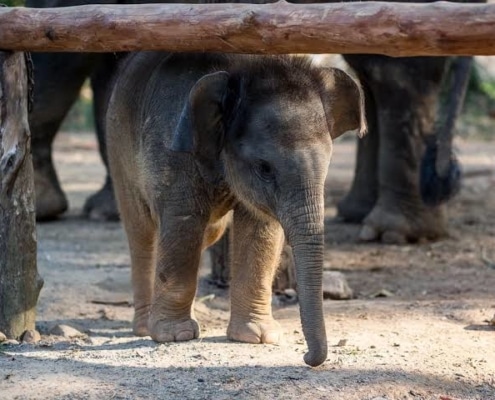
Females care for each other’s young. Sometimes if a mother dies, her sister or other family female will adopt her calf. Wild herds have even adopted elephants with no relation to them.
How long do elephants live?
Wild elephants live to about 60, or when their final set of teeth fall out and they cannot eat. In captivity, we can mash their food, so they can live much longer, usually to about 80. There are lovely stories of younger members of the herd chewing food to feed to an older frail elephant that has lost her teeth. The oldest elephant in the world is said to be an Asian elephant named Changalloor Dakshayani who reached 89 years of age.
What diseases do elephants get?
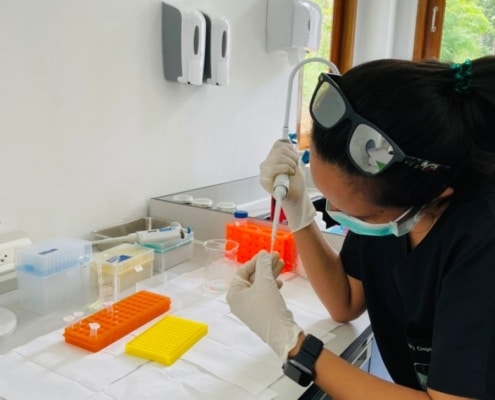
What causes death in elephants?
Among domesticated elephants, about 80% of hospital admissions are for digestive, lameness and eye problems. Infections make up only 3% of inpatient problems, but these can be the most serious. Elephant Endotheliotropic Herpes Virus (EEHV) is one of the main causes of mortality in young elephants. Although there are some treatments now available, these will only have a chance of success if the elephant can be got to hospital urgently for intensive veterinary care.
Causes of death in the wild include drought-related starvation and dehydration, and bacterial diseases such as anthrax. Diarrhoea and constipation can kill an elephant in 1-3 days. Wild elephants are also susceptible to the deadly EEHV.
Elephants have footpads made of fatty tissue, which cushion their feet and allow them to tread softly. If they walk on rough terrain, the footpads sometimes become worn down and dried out which can cause their footpads or toenails to get broken or infected. Their feet have the capability to splay out or to contract, meaning they can walk more easily through mud without slipping or getting stuck, but sometimes deep mud can be a danger and a cause of death in elephants, particularly young calves.
How big is an elephants brain?
At 5kg, the elephant has the biggest brain of all land mammals. Along with apes and dolphins, elephants have a very large brain compared to their body mass, which suggests a high capacity for learning. Elephants have a large, wrinkly neocortex (the outer layer of the brain) which is also seen in other intelligent species like apes, dolphins – and us! This may explain their ability to learn complex tasks by copying their parents.
Domesticated Elephants can learn up to 100 verbal commands from their handlers and, because they are so intelligent, they need plenty of natural enrichment to explore – visual, olfactory (smell) and tactile. They a good at solving problems both as a group and individually.
Read news story of elephant emotions
Elephants are long-lived animals and need to acquire a lot of information to survive. The well known phrase ‘an elephant never forgets’ reflects a remarkable recall power, They can recall other elephants – and people – they have crossed paths with perhaps decades ago. Wild elephants can recall alternative routes to food and water if the first option is unavailable in a drought. They also remember a variety of dangers and, as a group, will respond appropriately, usually led by the leader of the herd. Domesticated elephants tend to rely on their handler (mahout) to reassure them about any perceived danger.
Parts of the elephant brain are especially big, like the hippocampus (used for memory) and the amygdala (central to emotion). Elephants have also been seen to show symptoms of post-traumatic stress disorder, just like humans, and they mourn each loss from their herd. Wild elephants have been seen gathering to stand around or touch the old bones of their loved ones, or even non-relatives, as they walk back the same routes. Domesticated elephants have been known to ‘mourn’ their mahouts.
Elephants show signs of altruism (selflessness). There are numerous reports of them protecting or helping elephants they don’t know and even members of other species, with no gain to themselves. Read one of our news stories
When do elephants sleep?
Elephants are crepuscular – they are most active in the morning and evening. Adult Asian elephants dose mostly standing up, and lie down to sleep for around four hours each night. Calves take frequent naps in the day and at night. Elephants have to keep moving to find food to fuel their large bodies, so they can’t waste too much time sleeping!
How do elephants communicate?
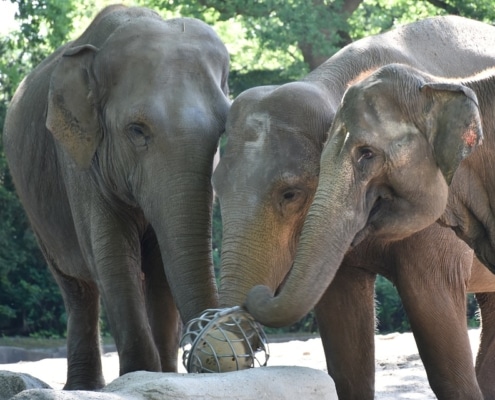
Emitting rumbles which only other elephants can detect reduces the risk of predators finding their infants. These rumbles travel as vibrations through the ground. Other elephants detect them with the sensitive skin on their trunk and footpads. Elephants understand different rumble signals (eg: mating, danger) and respond accordingly. Reports indicate that before the 2004 tsunami struck, elephants moved inland; perhaps they detected the tremors before we did.
How do elephants keep cool?

One very good reason for elephants having big ears is that they also use them to cool down, rather like fans, but importantly the flapping allows the air to permeate the thin skin of their ears and cool down the blood in the web of vessels before it circulates around the rest of the body.
Why are elephants so important in Thai culture?
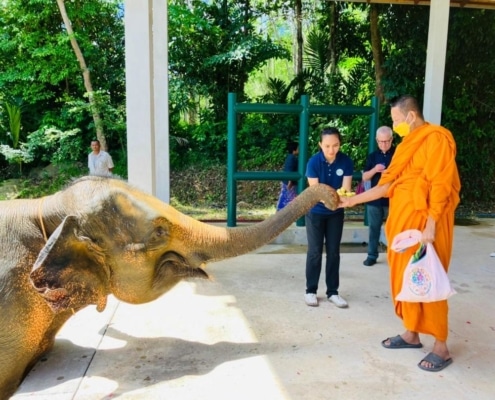
A rare few elephants are completely white-pink, and are called ‘white elephants’. These are considered very sacred to the local people and live under protection in many countries across Asia and India. They are not albino, but just have a lighter pigment in their skin than other elephants; in reality, they look more greyish or pinkish. Most notably, the King of Thailand had as many as 21 ‘white’ elephants in his time as a strong symbol of the monarch’s power.
The phrase ‘white elephant’ has a dual meaning these days, as it can also refer to a costly, or burdensome and useless possession. In Thailand, stories are told of kings gifting white elephants to disliked courtiers in order to ruin them financially. Culturally, it would have been considered very rude to pass these gifts on and it would also have been frowned upon to use them for any sort of useful manual labour, so the hapless courtier would be left to pay for the upkeep of his new elephants’ huge appetites.
Why are Asian elephants endangered?
Asian elephants are listed as an endangered species on the IUCN red list, and are among the top ten endangered species according the WWF. A hundred years ago, there were about 400,000 elephants in Thailand. Now, largely as a result of habitat loss caused by deforestation and changing farming practices (often resulting in elephant/human conflict), it is estimated that there are only about 3,300 wild elephants left in Thailand’s National Parks, and some 3,700 in private ownership.
Wild elephants sometimes migrate seasonally in order to access food and water. As natural resources become more scarce, herds may split up in order to survive and, as a result, elephant herds are now smaller than they used to be.
The illegal ivory trade has had an major impact on wild elephants. Killing elephants for their tusks has continued for millennia despite many bans (in 2012, Thailand’s prime minister pledged to outlaw the nation’s legal domestic ivory trade). Combined with habitat loss from expanded farming and deforestation, this has resulted in the Asian elephants’ endangered status.
Humans are the cause, and we must be the solution. We need to increase their numbers once again, through better health care and welfare, to prevent Asian elephants from becoming extinct.
How do we help increase Asian elephant population?
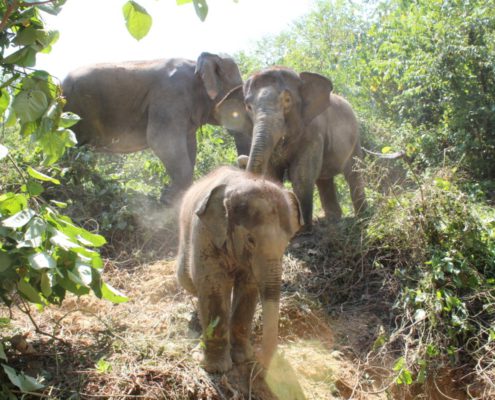
Around one in three Asian elephants live in captivity (one in two in Thailand), cared for by their mahouts who often have little access to the education, money, and medical support needed to care for their elephants as well as they would like – this was especially clear in the COVID19 pandemic and its after-effects, with many elephants going hungry as financial difficulties swept across the region.
It is important to understand that these animals cannot be released back into the wild. They have neither the social skills nor the cultural knowledge to survive on their own, and in many cases, due to the loss of natural habitat, they may not have a safe place to live. As these elephants live to almost the same age as most of their owners, they need long-term care to protect their future; at STEF (UK) we are working hard to provide the funds needed to support the free mobile clinic and the elephant hospital run by our sister charity, STEF Thailand.
We need to make sure we can continue to support the work of STEF Thailand so they can continue to provide their vital veterinary services to the local elephant communities who so desperately need them. Get involved today and gift to STEF, or sign up for our newsletter to get the latest news from Thailand.
African vs Asian Elephants
African elephants and Asian elephants are the only remaining species of the elephant family, but elephants once lived on every continent across the world, apart from Australia and Antarctica, inhabiting a range of environments from rainforests, to savanna to deserts.
Asian elephants have three main subspecies- Sumatran (the smallest and palest), Indian (in the middle) and Sri Lankan (usually the biggest and darkest). The world’s largest elephant on record was actually an Indian elephant – he weighed 7.7 tons and stood 3.43m tall! Elephants typically weigh up to 6.5 tons in Africa and 5.5 tons in Asia.
Elephants are unable to trot or run because they cannot have all four feet off the ground at the same time. But they can walk very fast: Asian elephants can move at 25 km/hour and African elephants can reach 40km/hour.
In African elephants, the males and females grow tusks, but in Asian elephants, it is normally only the males that have tusks. However a female Asian elephant can have “tushes”, which are basically very small tusks. The tusk is essentially an elephant’s incisor, albeit very elongated, and if an elephant loses his tusks, they do not grow back.
Some male Asian elephants never grow tusks – in Thailand these elephants are affectionately known as “ladyboys”.
African elephants have a strict hierarchy by age and are led by the oldest and wisest female, the matriarch. Wild Asian elephants have more changeable social networks.
There are about 400,000 African elephants left in the world, but only 40,000 or so Asian elephants. This is why Asian elephants have been classified as an endangered species by the World Wildlife Fund (WWF) and the International Union for the Conservation of Nature (IUCN), and why conservation and protection is so important to support their populations.
What do elephants eat?
Elephants get all their protein and nutrients from a low-energy plant-based diet (apart from when nursing in their first 4 years of life). Elephants have up to 19 metres of intestines, but only 40% of what they eat gets digested, so they need to eat for about 16 hours a day. Every day, elephants eat up to 300 kg (or 5% of their body weight), with healthy elephants grazing on up to 100 different species of plants in a year.
Elephants have the largest teeth of any mammal, and they get through six sets of molar teeth during their lifetime. They have four molar teeth which get replaced as they wear out. One tooth can weigh up to 5 kg and be up to 40 cm long. The surface of African elephant molars has a lozenge-shaped repeat pattern, whereas Asian elephant teeth have surface ridges. They chew their tough food by moving their jaw from side to side, like cows and sheep.
Baby elephants are born after a gestation period of 22 months, the longest of any mammal, and weigh around 250 pounds/113kg. As large animals require a lot of nutrients to grow, young elephants drink up to three gallons of their mother’s milk daily and can continue nursing for several years until the mother produces the next offspring. They start by eating soft food, sometimes their mother’s dung, which is full of nutrients.
An elephant’s trunk is essential for eating. It contains 40,000 muscles – 50 times the number in the human body. This enables it to twist, bend, extend and contract. The trunk also contains a large number of sensitive hairs, like cat whiskers, providing elephants with a very powerful sense of smell; they can detect water from several kilometres away. Adult elephants drink up to 200 litres of water a day and poop 16-18 times per day!
The jungle is also home to many natural remedies for their usual ailments, and elephants have evolved to be experts at identifying these.
How many calves do elephants have?
Asian elephants usually have one calf at a time, but very occasionally can have twins. Each female typically has about 5 calves in the course of her lifetime, and some dams are as old as 50, or even 60 years when they have their last calf. The elephant’s gestation period is 18-22 months – the longest in the animal kingdom.
Females care for each other’s young. Sometimes if a mother dies, her sister or other family female will adopt her calf. Wild herds have even adopted elephants with no relation to them.
How long do elephants live?
Wild elephants live to about 60, or when their final set of teeth fall out and they cannot eat. In captivity, we can mash their food, so they can live much longer, usually to about 80. There are lovely stories of younger members of the herd chewing food to feed to an older frail elephant that has lost her teeth. The oldest elephant in the world is said to be an Asian elephant named Changalloor Dakshayani who reached 89 years of age.
What diseases do elephants get?
Signs of sickness include loss of appetite, dry skin and changes in faeces and urine. A daily health check on a domesticated elephant includes an examination of the skin, feet, ears, mouth, trunk and teeth for infections or damage. Procedures carried out by our mobile vet clinic include vaccinations, blood screenings, vitamin injections, wound treatment and rehydration. Hospital procedures include treatment for serious digestive disorders, dehydration, infections and injuries, and diagnostic tests and X-rays. Most Thai mahouts cannot access these medicines and treatments without dedicated elephant hospitals like the STEF veterinary centre and mobile clinic, which are vital for the welfare of their elephants.
How tall is an elephant?
African elephants are the largest land animals on Earth, towering at an average height of about 10 to 13 feet at the shoulder, with some exceptional individuals reaching heights of up to 13 to 15 feet. In comparison, their Asian counterparts, while still impressively large, are slightly smaller, standing at an average height of around 8 to 10 feet at the shoulder. Despite the variation, both species command a formidable presence in their habitats, their majestic stature reflecting their importance in the ecosystems they inhabit.
How big is an elephant?
At 5kg, the elephant has the biggest brain of all land mammals. Along with apes and dolphins, elephants have a very large brain compared to their body mass, which suggests a high capacity for learning. Elephants have a large, wrinkly neocortex (the outer layer of the brain) which is also seen in other intelligent species like apes, dolphins – and us! This may explain their ability to learn complex tasks by copying their parents.
Domesticated Elephants can learn up to 100 verbal commands from their handlers and, because they are so intelligent, they need plenty of natural enrichment to explore – visual, olfactory (smell) and tactile. They a good at solving problems both as a group and individually.
Read news story of elephant emotions
Elephants are long-lived animals and need to acquire a lot of information to survive. The well-known phrase ‘an elephant never forgets’ reflects a remarkable recall power, They can recall other elephants – and people – they have crossed paths with perhaps decades ago. Wild elephants can recall alternative routes to food and water if the first option is unavailable in a drought. They also remember a variety of dangers and, as a group, will respond appropriately, usually led by the leader of the herd. Domesticated elephants tend to rely on their handler (mahout) to reassure them about any perceived danger.
Parts of the elephant brain are especially big, like the hippocampus (used for memory) and the amygdala (central to emotion). Elephants have also been seen to show symptoms of post-traumatic stress disorder, just like humans, and they mourn each loss from their herd. Wild elephants have been seen gathering to stand around or touch the old bones of their loved ones, or even non-relatives, as they walk back the same routes. Domesticated elephants have been known to ‘mourn’ their mahouts.
Elephants show signs of altruism (selflessness). There are numerous reports of them protecting or helping elephants they don’t know and even members of other species, with no gain to themselves. Read one of our news stories
What causes death in elephants?
Among domesticated elephants, about 80% of hospital admissions are for digestive, lameness and eye problems. Infections make up only 3% of inpatient problems, but these can be the most serious. Elephant Endotheliotropic Herpes Virus (EEHV) is one of the main causes of mortality in young elephants. Although there are some treatments now available, these will only have a chance of success if the elephant can be taken to the hospital urgently for intensive veterinary care.
Causes of death in the wild include drought-related starvation and dehydration, and bacterial diseases such as anthrax. Diarrhoea and constipation can kill an elephant in 1-3 days. Wild elephants are also susceptible to the deadly EEHV.
Elephants have footpads made of fatty tissue, which cushion their feet and allow them to tread softly. If they walk on rough terrain, the footpads sometimes become worn down and dried out which can cause their footpads or toenails to get broken or infected. Their feet can splay out or contract, meaning they can walk more easily through mud without slipping or getting stuck, but sometimes deep mud can be a danger and a cause of death in elephants, particularly young calves.
When do elephants sleep?
Elephants are crepuscular – they are most active in the morning and evening. Adult Asian elephants doze mostly standing up, and lie down to sleep for around four hours each night. Calves take frequent naps during the day and at night. Elephants have to keep moving to find food to fuel their large bodies, so they can’t waste too much time sleeping!
How do elephants communicate?
Elephants communicate over short distances with squeaks, grumbles and roars. They also communicate over several kilometres through deep rumbles which are sometimes too low in frequency for us to hear. They have a variety of vocal and visual signals, often including the equivalents of ‘hello’, ‘follow’ and ‘leave me alone’.
Emitting rumbles which only other elephants can detect reduces the risk of predators finding their infants. These rumbles travel as vibrations through the ground. Other elephants detect them with sensitive skin on their trunk and footpads. Elephants understand different rumble signals (eg: mating, danger) and respond accordingly. Reports indicate that before the 2004 tsunami struck, elephants moved inland; perhaps they detected the tremors before we did.
How do elephants keep cool?
Elephants like to lie down in mud and throw it over themselves to protect their skin from sunburn and from blood-sucking insects. They also use their trunks to spray sand or earth over their bodies to help them stay cool. Elephants don’t have sweat glands (except between their toes), so wherever possible they bathe in water for about an hour each day to cool down. The wrinkles and hairs in elephant skin trap water, helping to keep elephants cool even after bathing.
One very good reason for elephants having big ears is that they also use them to cool down, rather like fans, but importantly the flapping allows the air to permeate the thin skin of their ears and cool down the blood in the web of vessels before it circulates around the rest of the body.
Why are elephants so important to Thai culture?
The Asian elephant is the national emblem of Thailand and is revered as a symbol of longevity, loyalty, strength, family, community and good luck. Since Thailand is a majority Buddhist country, elephants are portrayed as sacred animals of their special symbolism in the practice of Buddhism.
A rare few elephants are completely white-pink, and are called ‘white elephants’. These are considered very sacred to the local people and live under protection in many countries across Asia and India. They are not albino, but just have a lighter pigment in their skin than other elephants; in reality, they look more greyish or pinkish. Most notably, the King of Thailand had as many as 21 ‘white’ elephants in his time as a strong symbol of the monarch’s power.
The phrase ‘white elephant’ has a dual meaning these days, as it can also refer to a costly, or burdensome and useless possession. In Thailand, stories are told of kings gifting white elephants to disliked courtiers to ruin them financially. Culturally, it would have been considered very rude to pass these gifts on and it would also have been frowned upon to use them for any sort of useful manual labour, so the hapless courtier would be left to pay for the upkeep of his new elephants’ huge appetites.
Why are elephants endangered?
Asian elephants are listed as an endangered species on the IUCN red list and are among the top ten endangered species according to the WWF. A hundred years ago, there were about 400,000 elephants in Thailand. Now, largely as a result of habitat loss caused by deforestation and changing farming practices (often resulting in elephant/human conflict), it is estimated that there are only about 3,300 wild elephants left in Thailand’s National Parks and some 3,700 in private ownership.
Wild elephants sometimes migrate seasonally to access food and water. As natural resources become more scarce, herds may split up to survive and, as a result, elephant herds are now smaller than they used to be.
The illegal ivory trade has had a major impact on wild elephants. Killing elephants for their tusks has continued for millennia despite many bans (in 2012, Thailand’s prime minister pledged to outlaw the nation’s legal domestic ivory trade). Combined with habitat loss from expanded farming and deforestation, this has resulted in the Asian elephants’ endangered status.
Humans are the cause, and we must be the solution. We need to increase their numbers once again, through better health care and welfare, to prevent Asian elephants from becoming extinct.
How do we help to increase the Asian elephant population?
Elephants are a flagship species – protecting them will save whole ecosystems. Ancient elephant migration routes are preserved across generations. Protecting these routes is vital to maintaining habitat connectivity, yet they continue to be under threat. Elephant activity distributes seeds and opens up the forest, creating habitats for new species to thrive. The conservation of wild elephant habitat is vital to the elephants and to the ecosystems they inhabit.
Around one in three Asian elephants live in captivity (one in two in Thailand), cared for by their mahouts who often have little access to the education, money, and medical support needed to care for their elephants as well as they would like – this was especially clear in the COVID19 pandemic and its after-effects, with many elephants going hungry as financial difficulties swept across the region.
It is important to understand that these animals cannot be released back into the wild. They have neither the social skills nor the cultural knowledge to survive on their own, and in many cases, due to the loss of natural habitat, they may not have a safe place to live. As these elephants live to almost the same age as most of their owners, they need long-term care to protect their future; at STEF (UK) we are working hard to provide the funds needed to support the free mobile clinic and the elephant hospital run by our sister charity, STEF Thailand.
We need to make sure we can continue to support the work of STEF Thailand so they can continue to provide their vital veterinary services to the local elephant communities who so desperately need them. Get involved today and gift to STEF, or sign up for our newsletter to get the latest news from Thailand.
Do you want news, facts and updates direct to your inbox? Then sign up to the STEF newsletter now.

